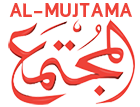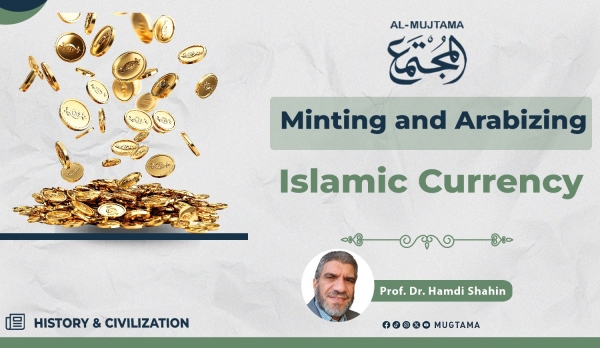Minting and Arabizing Islamic currency
The policy of Abd al-Malik ibn Marwan aimed at consolidating political power after the years preceding him were marked by conflicts and revolts. His policy also sought to affirm the independence of the state, both in its organization and by instilling an Arab-Islamic identity. This included his order to Arabize the administrative offices, which represented a significant turning point in the spread of Islam and the Arabic language, ensuring the integrity of its administrative apparatus, and tightening control over it. Additionally, he ordered the minting of a specific Islamic currency and its Arabization.
Minting of Islamic currency
The Islamic world continued to use the dirham (the currency of the Persians) and the dinar (the currency of the Romans) until a period during the caliphate of Abd al-Malik ibn Marwan (65-86 AH / 685-705 AD). However, the two great empires suffered due to the emergence of Islam. The Persian Empire collapsed under the blows of the great conquerors, and the Roman Empire was weakened, losing its richest kingdoms in the Levant, Egypt, and parts of North Africa. As a result, there was a scarcity of their currencies, and the Islamic state’s capacity to support its increasing commercial activities and economic needs with the coins of these two states diminished.
The collapse of the Sasanian political authority was enticing for counterfeiting its currency and cheating, and the weakness of the Byzantine state—which had its capital invaded by Muslims twice during the caliphate of Muawiya ibn Abi Sufyan and was still facing ongoing pressure—also encouraged the counterfeiting of its currency, leading to a decrease in its value and a loss of financial trust in its trade.
The decline in the value of the two currencies and the prevalence of fraud and forgery in them led to a decrease in the true value of the taxes imposed on non-Muslims, such as the jizya and kharaj. It also affected the value of zakat and charity paid by Muslims, as the differences in currencies and their weights and values created difficulties for them in their spending.
Some of those who rebelled against the Umayyad political system would initiate the minting of their own coins to signify their independence and assert their control. This was also done by Qatari ibn al-Fuja'a, the rebel leader, as well as Abdullah ibn al-Zubair in Mecca, and his brother Mus’ab ibn al-Zubair in Iraq.
In general, it was not fitting for the Islamic state – in its triumphant global version – to lack its own currency and financial system, a testament to its economic independence and its political and military stature.
Abdul Malik bin Marwan ordered the minting of the Islamic dinar in Syria in the year 74 AH, and then he expanded this measure to cover the regions of the state in the year 76 AH. The reasons mentioned above reflect a real need that preceded the apparent reason highlighted by historians. This is because the papyrus papers made in Egypt were exported to the Byzantine lands, while the dinars came from there to them. Therefore, Caliph Abdul Malik ordered the phrase "Say, He is Allah, the One" to be written at the top of the papers sent to the Byzantines. The emperor of Byzantium wrote back to him: "You have introduced in your papers a text we dislike; if you leave it, we will send you dinars that contain mentions of your prophet, which you will also dislike.
Abdul Malik felt it was important not to abandon the good practice he had established, so he called for the wise man of the Umayyads, Khalid ibn Yazid ibn Muawiya, and related the matter to him. Khalid responded, "Your generous heart, O Commander of the Faithful! Prohibit their dinars; do not allow transactions with them. Instead, mint coins for the people, and do not exempt these infidels from what they dislike in the heads of the papers." Abdul Malik replied, "You have alleviated my burden; may God alleviate yours!" and he ordered the minting of the dinars.
Abdul Malik's act when he announced the slogan of unification at the heads of the papers was not a hasty or hostile act. It has been reported that the Copts in Egypt—where paper is made from papyrus—used to mention Christ at the heads of their writings, attributing divinity to him, exalted be God above all. They would place the cross in place of "In the name of God, the Most Gracious, the Most Merciful." Abdul Malik changed all of this, which is why the Roman king disliked what he disliked and was greatly upset by the changes Abdul Malik made.
Abdul Malik ordered that the dinar and dirham be minted in the shape of a circle, with the inscriptions on them in parallel circles. On one side, the names of God are to be written in glorification, praise, and blessings upon the Prophet and his family, may God's blessings be upon him. On the other side, the date and the name of the caliph are to be inscribed.
Some researchers suggest – based on the dinars that have been discovered – that the Islamic dinar evolved from the Byzantine design to the complete Arabic style through three stages. The same was true for the illustrations and Arabic writing. This is an expected and understandable matter, as development is a general principle in cultural advancement and formation.
Abdul Malik ordered the unification of the currency standard, as “the dirhams minted by the non-Arabs varied in sizes, both large and small. They would mint a specific weight; a mithqal that weighs ten qirats, and they would mint weights of twelve qirats and ten qirats; which are half mithqals. When God brought Islam, and it was necessary to establish a middle ground for paying zakat, they took twenty qirats, twelve qirats, and ten qirats, totaling forty-two qirats. They created a coin based on one-third of that, which is fourteen qirats. Thus, the weight of the Arab dirham is fourteen qirats of the qirats of the noble dinar, resulting in the weight of every ten dirhams being seven mithqals, which was confirmed by the Prophet, peace be upon him, before. This legal weight was established as the norm, and it is clarified from the zakat obligation that in twenty dinars, there is half a dinar, and in two hundred dirhams, there are five dirhams. Therefore, half a dinar equals five large dirhams, and one dinar equals ten dirhams. This is consistent with what the Messenger of God, peace be upon him, enacted in the zakat levy, without any reduction or excess, thus establishing this practice, and the community has unanimously accepted it(1)
The caliph ordered the minting of coins in the rest of the regions, and he commanded his workers to submit a report to him every month detailing how many dirhams they had minted.
Read also: Reflections on Urban Development in Medina: Prophethood and Rightly Guided Caliphs Era
Ensuring the safety of the currency from counterfeiting
Abdul Malik ibn Marwan and his successors were strict about the safety of the currency from counterfeiting and fraud, and they punished those who engaged in such activities. It is reported that a man was caught minting coins not according to the Muslim standard, and he wanted to cut off his hand, but then he refrained from doing so and instead punished him, which the elders of the city appreciated. When Umar ibn Hubayrah was appointed to govern Iraq during the caliphate of Yazid ibn Abdul Malik (101-105 AH), he improved the purity of the silver more than his predecessors, refined the dirhams, and strictly adhered to the weight standards. Then Khalid ibn Abdullah al-Qasri took over and was even stricter regarding the currency than Ibn Hubayrah. Later, Yusuf ibn Umar (120-126 AH) governed Iraq and became excessively harsh, cutting off hands and imposing severe punishments. Thus, the currency minted during the reigns of Ibn Hubayrah, Khalid, and Yusuf was considered the best among the Umayyad coins.
The harshness of Yusuf bin Umar here indicates the growing attempts at currency manipulation in the late Umayyad period, to the point that they were compelled to exaggerate the punishment. It is not unlikely that there were fingers of opponents of Islam involved in this, nor that there were attempts from foes of the state and its political system, as many states and kingdoms have collapsed due to the collapse of their currency and the decline of their economy.


